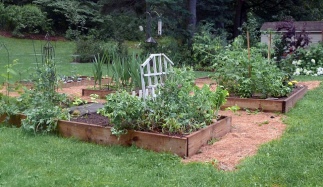Late winter into early spring can be a very exciting time to be connected to the outdoors. New growth can be seen on some plants while the daylight hours get longer and longer. The promise of a rich and bountiful growing season is right in front of us.
It is hard not to get a little bit antsy during this time of the year because it’s exciting to visualize the perfect set up for your growing space. Here are some tips on how to prepare your growing area to maximize the amount of fun and beauty you can have in the upcoming seasons!

Photo: Lori L. Stalteri
3 Tips to Prepare Your Garden for Spring
- Remove Hazardous Branches and Other Debris
Safety First! The very first step to take when planning your garden for the year is to take a step into your growing space. Check out all your pathways, steps, trails, planting beds, lawns or any other space you might venture into during the year. If there are any broken limbs or other debris that may have become a hazard during the winter months, take careful steps to remove them.
If the problem is too large for you to handle, consider hiring a contractor to help you. Clear enough area so you feel comfortable working in your environment.
- Create a Composting Area
The next step in preparing your garden for spring is to decide what you are going to do with all of the excess vegetation, branches and food scraps. Composting will turn your leftovers into a high quality product you can use for future growing as well as lower your transportation costs of removing the debris.
If you live on a large property, designate an area you can pile and churn your compost. Even people living in apartments can compost by building or purchasing a small composting unit. It can even be as small as a five-gallon-bucket. No matter where you live, you can take advantage of this powerful and all natural system. Plus, just knowing what to do with excess material will make growing a lot more fun.
- Check Soil Quality
Checking your soil quality is very important because it gives you valuable insight into how your soil will function. Call your local garden center, extension office or environmental services company for instructions on how to take a soil sample they can get accurate results from. Some key indicators to look for in your soil analysis are: pH, nitrogen, phosphorus and potassium.
The pH value will tell you whether your soil is acidic or alkaline. PH values range from 1-14. A low pH (1-7) is considered acidic while a high pH value (7-14) is alkaline. Most plants prefer a slightly acidic soil with a pH range from 5.5 – 7. Adjusting your soil pH is as easy as adding lime or sulfur. Add lime to lower pH or sulfur to raise the pH of your soil. Follow the instructions on the bag to ensure you add the right amount.
Nitrogen, phosphorus, and potassium (NPK) are the three macro nutrients that are most important for vigorous plant growth. Most soil and fertilizers are given an N-P-K value that is related to the amount of fertilizer in each product.
By using the original N-P-K value of your soil, you can add the right amount of the right product to prepare your soil for whatever you want to grow. Checking your soil before the growing season will give you the time to amend the soil before the plants actually need the right conditions.
That’s not all you can do to ensure a great growing season. Stay tuned for 4 more tips to prepare your garden for springtime!
Photo: hardworkinghippy
Jake Frazier is an outdoor enthusiast and the owner of Residential Ecology, a sustainable ecological resource management company. He uses existing natural systems to improve the quality of life for both humans and the Earth. Jake is interested in permaculture, living systems and exploring. Connect with him on LinkedIn.


[…] Getting Your Garden Ready for Spring, Part 1 & Part 2 from Aqua Berry Bliss […]
LikeLike
[…] the full article here on Aquaberry […]
LikeLike
[…] via Getting Your Growing Space Ready for Spring! Part 1 | Aquaberry Bliss. […]
LikeLike
Thank you so much for sharing our post!
LikeLike
Reblogged this on Residential Ecology.
LikeLike